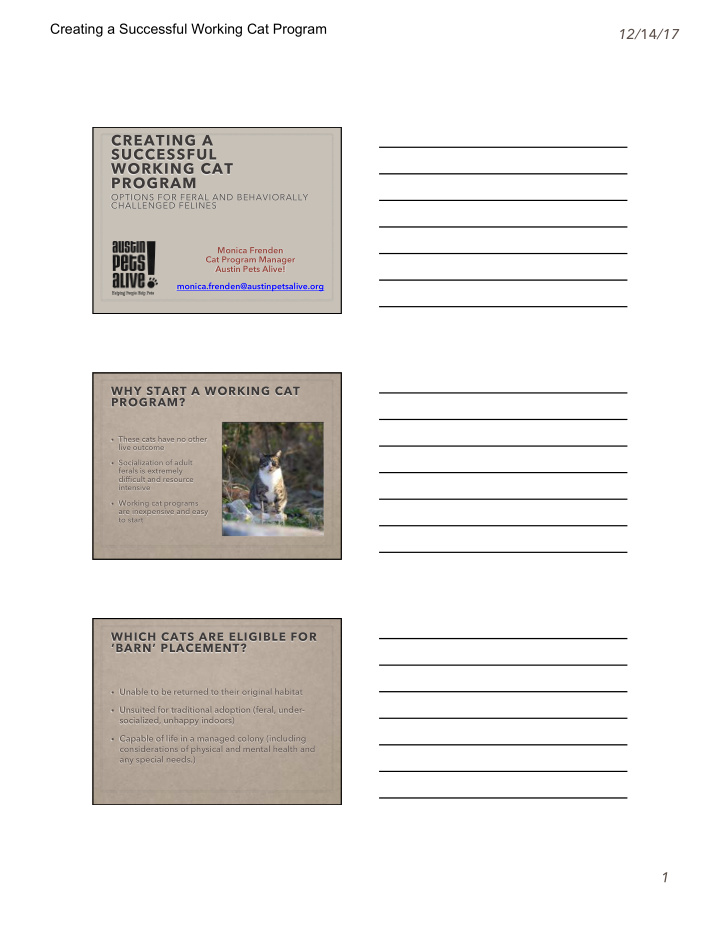



Creating a Successful Working Cat Program 12/ 14 /17 CREATING A SUCCESSFUL WORKING CAT PROGRAM OPTIONS FOR FERAL AND BEHAVIORALLY CHALLENGED FELINES Monica Frenden Cat Program Manager Austin Pets Alive! monica.frenden@austinpetsalive.org WHY START A WORKING CAT PROGRAM? • These cats have no other live outcome • Socialization of adult ferals is extremely difficult and resource intensive • Working cat programs are inexpensive and easy to start WHICH CATS ARE ELIGIBLE FOR ‘BARN’ PLACEMENT? • Unable to be returned to their original habitat • Unsuited for traditional adoption (feral, under- socialized, unhappy indoors) • Capable of life in a managed colony (including considerations of physical and mental health and any special needs.) 1
Creating a Successful Working Cat Program 12/ 14 /17 CATS APA! DOES NOT BARN PLACE: • Kittens under 16 weeks are sent to foster for socialization • Declawed cats* • Geriatric cats* • Cats who can be returned to habitat or remain in their habitat through conflict resolution • However, alternative, creative placement is always an option for any cat who is at risk! SHELTERING FERAL CATS STRESS REDUCTION IS KEY! • A stressed cat = a sick cat. • Dedicated quiet room • Housing considerations (feral cat dens, cover condo up, artificial light cycles) • Appropriate handling (or lack thereof), including medical treatments - wildlife rehab model • Feeding considerations (types of food, timing of food) • Quick turn around time from intake to adoption • Outdoor habitats always better, but not necessary to begin $75 “FERAL CAT DENS” ANIMAL-CARE.COM LIVETRAP.COM 2
Creating a Successful Working Cat Program 12/ 14 /17 HOUSING FERALS AT THE SHELTER $50 HOUSING FERALS AT THE SHELTER $700 $1500 FINDING HOMES FOR WORKING CATS WHAT TYPES OF HOMES ARE SUITABLE? • Farms / Ranches • Stables • Warehouses / Factories • Greenhouses / Nurseries • Wineries / Distilleries • Junkyards • Churches • Storage facilities • Shops: Repair shops, woodworking shops, retail stores • Residential homes 3
12/ 14 /17 Creating a Successful Working Cat Program FINDING HOMES: RURAL LOCATION AND ADOPTER REQUIREMENTS • Off busy roads • No recent predation • Shelter provided • Daily food and water • Long term vet care, as needed • Willingness to confine cats for the relocation period FINDING HOMES: SUBURBAN • Garage cats rock! • Ensure neighborhood is ‘cat friendly’, HOA rules • Great fit for cats who are more social FINDING HOMES: URBAN • Retrofit space under deck or porch for shelter • Try to place ‘city cats’ back to city neighborhoods • Market to urban areas struggling with rat problems 4
Creating a Successful Working Cat Program 12/ 14 /17 ADVERTISING TO FIND GOOD HOMES • Your website - have an online adoption application • Newspapers • Flyers, post them anywhere farmers, animal lovers, or equestrians go • Craigslist • Equine clubs, publications, trail rides, and events • Farmer’s markets, county fairs, horse shows • Radio • NextDoor • Facebook neighborhood groups ADOPTION APPLICATION: MUST BE ONLINE! • Include info on your program and then the application • Application on your website, easily findable • Short, simple application 5
12/ 14 /17 Creating a Successful Working Cat Program Non-Toxic Messaging • farmers markets • nurseries/ greenhouses • keeps rodenticides from entering watersheds and killing raptors • communities that value organic living • hang in adoption centers • mailbox banks • ask volunteers to print, keep in car, and hang up • put up flyers anywhere you might shop if you owned 5 acres of land Newspaper ads • Still effective for rural communities • Often free to run in unused space 6
12/ 14 /17 Creating a Successful Working Cat Program YOUR FRIEND, THE HORSE. • Every horse barn in the world needs cats. • Riding clubs, horse shows, fairs, events are all prime marketing opportunities • Dressage barns, polo clubs, riding school, training barns, police stables BARN CAT PROGRAMS = MEDIA DARLINGS! “STUNT PLACEMENTS” 7
12/ 14 /17 Creating a Successful Working Cat Program HOW TO PLACE THE CATS: RELOCATION PROCESS best known practices • Crate kept inside building/barn where cats will live • Cats confined for 2 to 4 weeks. (2 weeks is minimum, 4 weeks is optimum) • Feed cats and clean crate daily, plan for mess! • Feed canned food daily and make a special ‘call’ to teach the cats the sound of your voice = food • At the end of 4 weeks, crate door left nonchalantly open for the cats to exit at their will. THE RELOCATION CRATE and the art of the Hidey Box THE WHOLE PROCESS STEP-BY-STEP, APA! STYLE 8
12/ 14 /17 Creating a Successful Working Cat Program STEP 1: CHECK APPLICATION FOR SUITABILITY STEP 2: GOOGLE MAPS IS YOUR FRIEND! STEP 3: DETAILED EMAIL IS SENT STEP 4: ADOPTER RESPONDS, WORK OUT THE DETAILS, SEND KITTIES HOME! 9
12/ 14 /17 Creating a Successful Working Cat Program STEP 5: FOLLOW UP APA! follows up with all barn cat adoptions at: 1 week 3 months 1 year IS IT WORKING? Data on over 3,000 barn placements: • Long term success rate 85+% • Predation accounts for less than 2% of loss • Most frequent cause of adopted cat missing = ran away and/or living elsewhere MADDIE’S FUND & APA! APPRENTICESHIP SUCCESSES 10
12/ 14 /17 Creating a Successful Working Cat Program FAQ • Adoption fees • Crate deposits • Home checks • Excessive hoop-jumping FAQ • Adopt all year long • Adopt cats in pairs (unless you have a cat-hating singleton) • Make adoption easy • Provide the tools for success 11
Recommend
More recommend